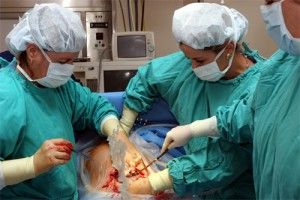Study: CA hospitals waste money by ignoring ‘big data’
by Chris Reed | May 12, 2015 5:00 am
 The “Moneyball” phenomenon of using advanced statistical analysis to gain advantage in professional sports has picked up steam over the past dozen years, to the point where it has broadly depressed scoring in baseball, as fielders are positioned precisely based on the historical patterns of individual hitters. But in the private sector, numbers-driven “best practices” policies of figuring out what works and sticking with it have been around for decades.
The “Moneyball” phenomenon of using advanced statistical analysis to gain advantage in professional sports has picked up steam over the past dozen years, to the point where it has broadly depressed scoring in baseball, as fielders are positioned precisely based on the historical patterns of individual hitters. But in the private sector, numbers-driven “best practices” policies of figuring out what works and sticking with it have been around for decades.
This is why experts are both encouraged and frustrated by new research [1]by the California HealthCare Foundation on how to control the costs of childbirth while making it safer than ever. The study is encouraging because it suggests considerable savings are readily achieved if “best practices” are routinely followed, but frustrating because it shows how slow the health care establishment in California has been to embrace the approach.
Caesarean section births cost an average of $19,000, the survey found, versus $11,000 for normal childbirth. C-sections should only be used if there are serious chances of a complication during normal childbirth, experts say, but are routinely used for low-risk births — even though major surgery has many possible complications and risks of its own. The CHCF study found that[2] in well-run California hospitals, 19 percent of births are C-sections vs. 58 percent in poorly run hospitals. The national average is 33 percent.
The study also found better hospitals only use episiotomies — which make it easier for a baby to emerge from the womb — 2 percent of the time versus 46 percent in less well-run hospitals. Better hospitals were also far more vigilant in promoting breastfeeding and in exploring whether a woman who had her first child by C-section needs a C-section for her second child. Well-run hospitals are vastly more likely to recommend regular vaginal births with such women than poorly run hospitals.
Money and peer pressure pay off
The wide variance in how hospitals deal with something as fundamental as childbirth is seen as one more byproduct of a complex health care system in which a third party (insurers or the government) often pays the cost of care provided to patients.
 Kaiser Health News, however, had an encouraging report[3] recently about Hoag Memorial Hospital Presbyterian in Newport Beach and how it has prompted doctors to stop recommending C-sections to women facing little risk of difficult childbirths. It involves both educating the physicians and a degree of shaming.
Kaiser Health News, however, had an encouraging report[3] recently about Hoag Memorial Hospital Presbyterian in Newport Beach and how it has prompted doctors to stop recommending C-sections to women facing little risk of difficult childbirths. It involves both educating the physicians and a degree of shaming.
At Hoag, where more than 6,000 babies are born each year, [Dr. Allyson] Brooks and other administrators knew that they had to focus on changing the mindset and behavior of physicians. “Hospitals don’t do C-sections, doctors do,” she said.
So they took some aggressive steps. First, they shared the data with all the physicians in the department without names — then decided to reveal the names. Suddenly, everyone knew who had exceeded or come in under the average.
“There was a lot of upheaval,” Dr. Jeffrey Illeck, a community OB-GYN and the hospital’s obstetrics department chair. “None of us want to look bad in front of our peers. … And some looked horrible.”
Some physicians reacted with surprise and frustration. Initially, many attributed the high rates to the patients, saying they were older, had more complicated pregnancies or demanded scheduled C-sections. …
Dr. Amy VanBlaricom, an OB-GYN who delivers about 25 to 30 babies a month, … said being aware that Hoag is monitoring the C-sections has changed how she thinks about her practice and has encouraged her to let women remain in labor longer.
That’s what Hoag administrators were aiming for – a realization among doctors that C-sections should not be undertaken lightly. They carry surgical risks, including serious infection and blood clots, and require longer hospital stays.
Bending the ‘cost curve’ of medicine
The idea floated by advocates of the Affordable Care Act — that the U.S. government could change the “cost curve” of medicine to achieve major savings — wasn’t well-explained by many Washington reporters. Encouraged by official [4]reports[5], they often focused on the idea that preventive care would be the change agent.
But as the C-section research shows, the change agent could be the “big data” approach. It may have the potential to bring U.S. health care costs more in line with those seen in other advanced countries — so long as there are incentives to encourage physicians and hospital administrators to try to do what’s most sensible, not what’s easiest.
- research : http://www.chcf.org/publications/2014/11/tale-two-births
- found that: http://www.chcf.org/~/media/MEDIA%20LIBRARY%20Files/PDF/T/PDF%20TaleOfTwoBirthsInfographic.pdf
- encouraging report: http://ww2.kqed.org/stateofhealth/2015/05/10/how-one-hospital-brought-its-c-section-rate-down-in-a-hurry/
- official : http://www.urban.org/research/publication/role-prevention-bending-cost-curve
- reports: http://www.ncbi.nlm.nih.gov/books/NBK53914/
Source URL: https://calwatchdog.com/2015/05/12/study-ca-hospitals-waste-money-ignoring-big-data/